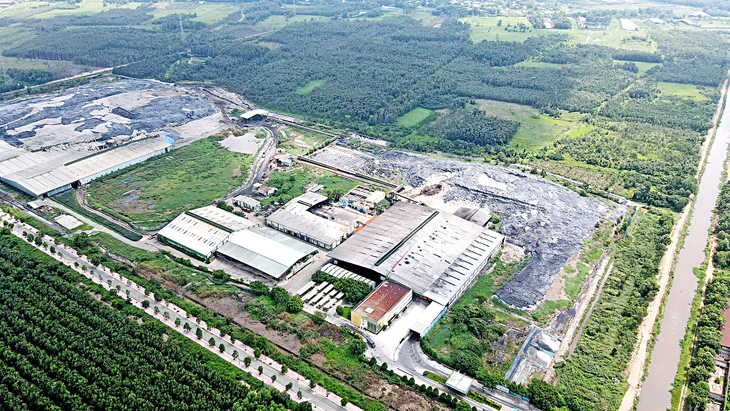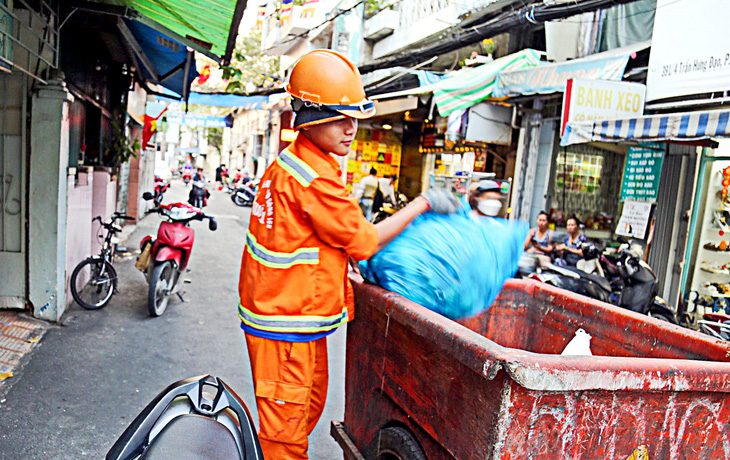Two waste-to-energy projects in Ho Chi Minh City have yet to be completed although work on them started in 2019 and they were expected to treat thousands of metric tons of garbage starting in 2020.
The projects are funded by Vietstar Joint Stock Company and Tam Sinh Nghia Investment - Development Joint Stock Company in the Tay Bac Solid Waste Treatment Complex in Cu Chi District.
The waste volume in the city increases annually, while burying waste is out-of-date and causes environmental pollution.
As a result, Ho Chi Minh City needs to accelerate and put into operation waste-to-energy projects.
Vietstar Joint Stock Company has completed the installation and operation of three waste sorting lines, constructed a 27-meter-wide road leading to the plant, leveled a construction site measuring 45,000 square meters, and signed contracts and made deposits for main equipment imports, Ngo Nhu Hung Viet, general director of the company, told Tuoi Tre (Youth) newspaper.
However, the firm has yet to develop the plant due to legal obstacles, Viet added.
Similarly, the waste-to-energy project of Tam Sinh Nghia Investment-Development Joint Stock Company has been put on hold for a long time.
The two companies cannot complete their projects as the projects are not included in a national plan on developing power using solid waste, said Nguyen Toan Thang, director of the Ho Chi Minh City Department of Natural Resources and Environment.
The companies have faced difficulties in applying for construction licenses from the Ministry of Construction.
The Ho Chi Minh City Department of Natural Resources and Environment has urged the municipal People’s Committee propose the Ministry of Construction weigh issuing temporary construction licenses for the projects as they are aimed at treating waste using modern technology, not at generating electricity.
The government on May 15 issued the National Power Development Plan VIII, which is an important legal ground for Vietstar and Tam Sinh Nghia to conduct their projects.
The city has allowed the two companies to build tents for workers, warehouses for building materials, and fences.
The two companies will complete dossiers for the construction license application and get prepared to develop the projects once getting the licenses.
Ho Chi Minh City discharges some 9,800-10,000 metric tons of waste per day, according to the Department of Natural Resources and Environment.
Key treatment facilities in the city are plants of Vietstar and Tam Sinh Nghia and Da Phuoc Waste Treatment Complex in Binh Chanh District with a respective capacity of 1,800, 1,000-1,400, and 6,000-6,800 metric tons per day.
The waste volume in the city is forecast to increase to 13,000 metric tons per day by 2025 and 16,600 by 2030, according to the city’s solid waste treatment plan by 2025 with a vision to 2050.
Thang said the development of waste-to-energy plants is vital amid the huge volume of discharged waste.
|
|
| An employee collects garbage in Alley 391 on Tran Hung Dao Street, District 1, Ho Chi Minh City. Photo: Phuong Quyen / Tuoi Tre |
However, the city must choose waste treatment facilities through tenders. If the city cannot hold tenders, it can assign the job to certain companies, pursuant to the 2020 Law on Environmental Protection.
This means that some units converting to waste-to-energy technology may not have waste for treatment.
For example, the plant of Vietstar has a capacity of 2,000 metric tons of garbage per day but the city has assigned the company to treat 1,200 metric tons per day.
Tam Sinh Nghia’s plant with a daily capacity of 2,000 metric tons of waste is operating at half of its capacity.
As a result, other companies are not keen on developing waste-to-energy plants as they are afraid of having no waste for treatment.
Vietnam expects to reduce the proportion of the buried waste volume in cities to 30 percent by 2025 and 10 percent by 2030, according to the national environment protection strategy approved by the prime minister.
Ho Chi Minh City is projected to recycle and generate electricity from some 80 percent of its waste volume by 2025 and 100 percent by 2030.
The Department of Natural Resources and Environment has proposed the municipal People’s Committee add policies on the waste treatment services to a draft resolution on special policies and mechanism for Ho Chi Minh City to remove difficulties of waste treatment units and encourage them to convert to advanced technology.
The government has greenlighted the proposal and submitted it to the National Assembly for consideration and approval.
If the draft resolution is passed, it will pave the way for the city in waste treatment, according to the Department of Natural Resources and Environment.
The department will continue urging companies to complete dossiers for waste-to-energy projects and keep a close watch on their progress.
The department will coordinate with the Department of Planning and Investment and other relevant agencies to propose the city impose sanctions on those failing to ensure the progress of these projects.
Like us on Facebook or follow us on Twitter to get the latest news about Vietnam!




















































